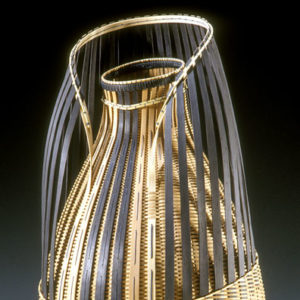calsfoundation@cals.org
Leon Albert Niehues (1951–)
Leon Albert Niehues is a highly regarded basket maker in the United States and internationally. In 2002, he was chosen by his peers as one of the top twenty-eight fiber artists working the “new basket” form in the United States.
Leon Niehues (pronounced: “nee house”) was born to Edwin and Rosalita Niehues on July 13, 1951, in Seneca, Kansas, and raised on a farm with six siblings, including a twin. Niehues attended the University of Kansas in Lawrence for two years.
Niehues married Sharon Coffey on May 1, 1974, in Lawrence, and the couple spent their honeymoon in Arkansas at a Madison County hunters’ cabin. They liked the state so much that they decided to stay. They bought forty acres of land with hard wood trees near Pettigrew (Madison County) in 1974, and Niehues got a job working at a local sawmill.
After seeing the traditional utility baskets made in Arkansas, the couple decided to make their own. Niehues bought a tool from a retired basket maker and learned to make baskets by reading a University of Arkansas Cooperative Extension Service (UACES) booklet on the process of making white oak baskets. Their first baskets were sold at the spring War Eagle craft fair in 1982. They sold twenty-one baskets for $20 or $40 apiece, depending upon size.
Niehues quit his sawmill job in 1981 to work in his studio. Once the basics were under control, Niehues and his wife strove to refine and embellish their forms. They achieved this with extraordinarily fine weavers shaved to veneer thickness. These thin splints were made by carefully following the growth rings of the log. The couple then developed their signature “overlay” basket, a style in which a basket of vertically shaped ribs is interwoven with extraordinarily fine weavers. The basket is then overlaid with a second set of ribs sewn with waxed linen thread to the basic body. This technique strengthens the body of the basket and reinforces its profile, giving it an individual character. As collaborative work, the ribs (sometimes considered “masculine”) suited Niehues, while the weavers were exceptionally pliable and thin—considered “feminine”—and suited Sharon; that is, he would start and finish the work, while she did the middle.
By 1987, the Niehueses were exploring new ways of making handles and patterns. Their work began as traditional, but they altered the technique for a more refined look. This concern for detail helped place them into the field of contemporary fiber artists who were experimenting with basket making as an alternative to weaving on a loom. Unlike tapestry making, basket making allowed an artist to express creative ideas in a shorter time.
In the early 1990s, Sharon developed physical problems, such as chronic fatigue, and had to give up the collaboration. Their children, Matthew, Evan, and Ruth, became Leon’s assistants.
Niehues began to experiment and make baskets with square instead of round cross-sections. His baskets were both symmetrical and asymmetrical. With the inclusion of an additional rib, the body became misshapen and leaned in a particular direction, which affected the profile and is often discussed as movement or gesture.
His works are made of materials native to Arkansas: long white oak splints and coral berry runners, with waxed linen thread to tie the elements together. Color was introduced by soaking the splints in tubs with a few rusted nails, and later in his career, Niehues began to use ferrous oxide and walnut hulls.
In 2002, Niehues exhibited a startlingly different creation in the Baskets Now U.S.A. exhibition at the Arkansas Arts Center (now the Arkansas Museum of Fine Arts). The basket structure consisted of long, linear, thin split oak splints that were bolted, rather than tied together with linen thread, into an open graceful armature or scaffolding. The inside was lined with black emery cloth. The new direction was innovative, but also paid homage to basket maker John Garrett, who frequently used industrial components in his contemporary baskets.
Niehues’s work is clean, strong, sinuous, tactile, visually appealing, and exhibits strong natural color. Many have bold design elements at the rims or front. Niehues’s work, rooted in traditional basket-making techniques of the nineteenth century, is well-crafted, but some collectors and enthusiasts consider it to be pushing the form into more of a contemporary idiom as an object to be contemplated for its beauty alone.
In 2002, Niehues was chosen by his peers as one of the top twenty-eight fiber artists making the “new basket” in the United States. On May 5, 2005, Niehues was recognized by the Department of Arkansas Heritage and the Arkansas Arts Council as the 2005 Arkansas “Living Treasure” at the Historic Arkansas Museum in Little Rock (Pulaski County), an honor earned after twenty-four years of solid work. His work is represented in the collection of the Arkansas Museum of Fine Arts in Little Rock; the Huntington Museum of Art in Wheeling, West Virginia; the Racine Art Museum in Racine, Wisconsin; and the White House Craft Collection, which is now part of the William J. Clinton Presidential Library. In 2013, he gave a lecture about his art and his life in Arkansas as part of the James Renwick Alliance Distinguished Lecture series at the Smithsonian Institution.
For additional information:
Du Bois, Alan. Arkansas Year of American Craft 1993. Exhibition catalogue. Little Rock: Arkansas Arts Center, 1993.
———. Baskets Now U.S.A. Little Rock: Arkansas Arts Center, 2002.
Leon Niehues. http://www.leonniehues.com/ (accessed July 11, 2023).
Niehues, Leon. “Leon Niehues—A Lifetime of Risks.” National Basketry Organization “NBO” News 5 (January 2005): 1–11.
Paulson, Deborah. “Tilting Form and Texture.” Craft Arts International 49 (2000): 44–46.
Widner, Ellis. “Reinventing the Basket.” Arkansas Democrat-Gazette. November 6, 2011, pp. 1E, 6E.
Alan Du Bois
Little Rock, Arkansas
 Arts, Culture, and Entertainment
Arts, Culture, and Entertainment Niehues Basket
Niehues Basket  Leon Albert Niehues
Leon Albert Niehues 




Comments
No comments on this entry yet.